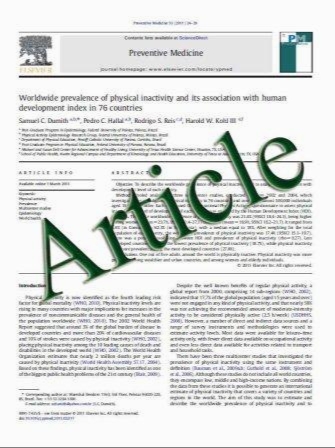Sustained skeletal benefit from childhood mechanical loading
- نوع فایل : کتاب
- زبان : انگلیسی
- مؤلف : T. A. Scerpella & J. N. Dowthwaite & P. F. Rosenbaum
- چاپ و سال / کشور: 2010
Description
Summary Preliminary prospective, longitudinal results suggest that pre-menarcheal exposure to artistic gymnastics is associated with greater radius BMC, aBMD, and projected area throughout growth and into early adulthood, more than 4 years after activity cessation. Any loss of benefit associated with detraining appears to be temporary. Introduction Mechanical loading may enhance bone accrual during growth, but prospective evidence of benefit retention is limited. This prospective, longitudinal cohort study tests whether gymnastics is linked to distal radius advantages during growth and four or more years posttraining cessation. Methods Semi-annually, female ex/gymnasts and nongymnasts underwent height and weight measurements; questionnaires assessed calcium intake, physical activity, and maturation. Annual dual energy X-ray absorptiometry scans (Hologic QDR 4500W) measured total body fat-free mass, skull areal density (aBMD), and bone mineral content (BMC); forearm scans measured ultradistal and 1/3 radius area, BMC, and aBMD. Analysis inclusion criteria were: (1) achievement of gynecological age >4 years and (2) for gymnasts, >2 years of pre-menarcheal training (>6 h/week), ceasing between 0.5 year pre-menarche and 1 year postmenarche. Hierarchical linearmodeling (HLMv6.0) evaluated outcomes for ex/gymnasts versus non-gymnasts; a slope/ intercept discontinuity evaluated de-training effects. Results Data from 14 non-gymnasts and six ex/gymnasts represented outcomes from 4 years pre-menarche to 9 years post-menarche. All adjusted distal radius parameters were higher in ex/gymnasts than non-gymnasts (p<0.02). Ultradistal BMC, ultradistal aBMD, and 1/3 aBMD temporarily decreased with gymnastic cessation (p<0.04); ultradistal area, 1/3 area, and 1/3 BMC did not change significantly. Skull outcomes did not differ between groups or change with activity cessation. Conclusion Gymnastic exposure during childhood and early puberty is associated with greater radius bone mass, size, and aBMD. Despite brief de-training losses in density and mass, significant skeletal benefits are manifested throughout growth and at least 4 years beyond activity cessation into early adulthood.
Osteoporos Int (2011) 22:2205–2210 DOI 10.1007/s00198-010-13Received: 17 March 2010 / Accepted: 11 August 2010 / Published online: 14 September 201073-4


